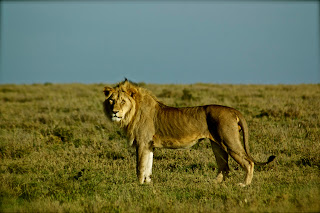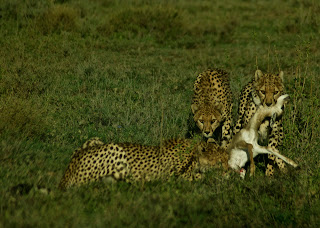The following photos are all taken with my iPhone on three safaris through the northern Tanzania, with Serengeti as the feature.

I'll start with a photo of the guides who co-guided with me on the trips. It is common knowledge that the guides make a trip, they keep you safe, host you, and give deeper insight into the wildlife and ecology of the savanna. With no more than four guests per guide we keep a ratio that ensures everyone gets the right amount of attention. Thank you Robert Tarimo and Paul Oliver.

The theme of many of these photos could be about big sky. This male giraffe seems dwarfed by the plains and sky. Since I only use my phone for photos, I don't use any zoom. This photo was taken en-route to Asilia's Namiri Plains Camp. Because of my previous work for Asilia, I am one of few guides allowed to drive in the camps where they normally only want people guided by their guides.

Again- the skies in the Serengeti provide this impressive backdrop fro wildlife viewing. This photo was taken on Christmas day. If you look carefully you can see one of the vehicles (driven by Paul Oliver who guided with me on this trip) to the left of the big rock kopjie. You can't see the lions they were watching.

Without using a zoom you'd have to be in a park with very habitated black rhinos to get a close up just using a phone. This is a black rhino and her calf only a few hundred meters from where we camped. Unfortunately rhino poaching still continues and there are very few rhino that are still left in Serengeti.

I'm often late for lunch- and on this occasion we were nearly back in camp but found this pod of hippos basking in the sun along the banks of the Mara river. While things are getting busier every year, this part of Serengeti is very quiet outside of migration season and while some of the animals are harder to find, it is a great place to be alone especially.

An elephant herd feeding along the main road at Bologonja. While flying between camps is often the most efficient way to maximize the wildlife experience, driving the vast distances does give you an understanding of the vastness of the ecosystem.

This old male lion was pretty beaten up but still trying to keep up with the pride. When the wildebeest move out of the north, lion prides that have had it easy suddenly find their territories tight and must venture further to find food and keep alive. This often leads to territorial fights between neighboring prides. Prides often divide into subgroups that are easier to feed, but this creates issues for the males who now risk their lionesses running into nomadic or roaming males.

A picnic breakfast in the Serengeti can be a 5-star buffet or a tailgate affair as below... as long as there is hot coffee I'm fine.


The choice of accommodation is yours. Do you want the ultra-luxury that Mwiba or Singita properties offer or would you rather keep it simple as below. For me, safari should be about the wildlife experience and the landscapes. With good guides, the experience you have at either the luxury or the simple camps will be very good.


Cats on rocks... doesn't get much better than this. It was pretty hot in the morning but with 15 cubs, these lioness were hungry. We found them walking along the road before they climbed onto these rocks to get a better view of prey in the long grass.






















































































































